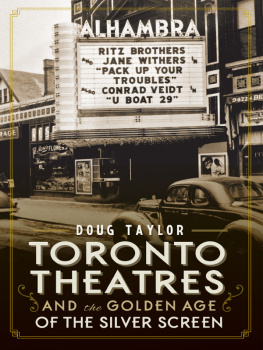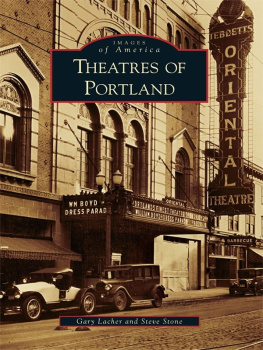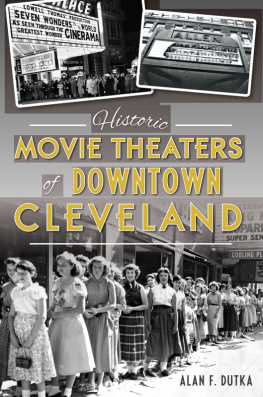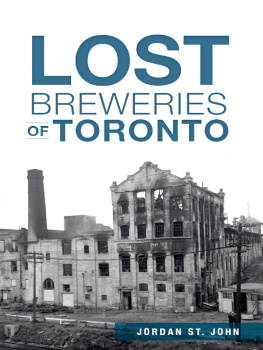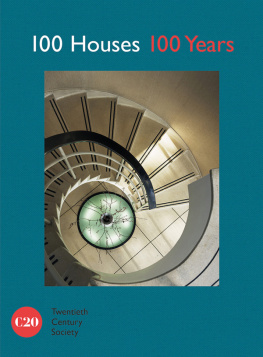
Published by The History Press
Charleston, SC 29403
www.historypress.net
Copyright 2014 by Doug Taylor
All rights reserved
Images courtesy of the author unless otherwise noted.
First published 2014
e-book edition 2014
ISBN 978.1.62584.982.3
Library of Congress Cataloging-in-Publication Data
Taylor, Doug, 1938
Toronto theatres and the golden age of the silver screen / Doug Taylor.
pages cm
Includes index.
print edition ISBN 978-1-62619-450-2
1. Motion picture theaters--Ontario--Toronto--History--20th century. I. Title.
PN1993.5.C2T39 2014
791.4309713541--dc23
2014022051
Notice: The information in this book is true and complete to the best of our knowledge. It is offered without guarantee on the part of the author or The History Press. The author and The History Press disclaim all liability in connection with the use of this book.
All rights reserved. No part of this book may be reproduced or transmitted in any form whatsoever without prior written permission from the publisher except in the case of brief quotations embodied in critical articles and reviews.
CONTENTS
PREFACE
Several years ago, I commenced publishing a blog (tayloronhistory.com) about Torontos Heritage Buildings and eventually included posts about Torontos old movie houses. Seeking further information about the theatres of yesteryear, I searched for books to assist me, only to discover that very few were available. However, I secured a copy of John Seberts book The Nabes, published in 2001. I thoroughly enjoyed it, as it excellently chronicled Torontos neighbourhood theatres, referred to as nabes, but it did not include the movie houses located in the citys downtown.
Most of us attended neighbourhood theatres only until we were of an age to travel farther afield. Then, as teenagers, the downtown movie houses became the main attraction. Attending them became high adventure. After all, few memories in life are more golden than those of our teenage years, and in the past, movie theatres played a major role during the formative years of many teenagers. To some extent, this remains true today.
Despite including the downtown theatres in this book, it is not a comprehensive study of the old movie houses of Toronto. There are too many to accomplish this within a single edition. As a result, I have selected a combination of downtown and local theatres, from the earliest days of cinema to the arrival on the Toronto scene of multiplex theatres and the Bell Lightbox, headquarters of the Toronto International Film Festival (TIFF). I retain fond memories of many of the theatres mentioned and have included personal anecdotes, as well as stories from those whom I interviewed.
While researching the old movie theatres, I discovered that much of the information has already been lost and that what remains is sometimes contradictory. The opening and closing dates for theatres are often in dispute, depending on the source. The records on file often disagreed on the number of seats in the theatres, as they frequently changed due to installing candy bars or being renovated to increase seating capacity. However, I consider these details inconsequential. My main purpose is to preserve the memories of attending these wonderful theatres. I have attempted to verify the information and consulted multiple sources wherever feasible, but this was often impossible. However, every effort has been made to ensure that the information is as accurate as possible. I also found that sometimes the information I discovered did not agree with my personal memories. This created difficulties when writing about the theatres. Some of the discrepancies I never resolved, leading me to think that my memory is not as accurate as I had previously thought. However, I must accept the blame for any errors contained in this book.
Similarly, due diligence has also been given to locate the sources and provide the proper credits for the photos that are included. If any are incorrect, I sincerely apologize and would be grateful to receive information to correct the errors. Future editions of the book and electronic versions would certainly include these corrections.
The files of the City of Toronto Archives were the most comprehensive, and I wish to gratefully acknowledge the expertise of the archives staff, particularly Glenda Williams, whose knowledge of the files was amazing. In the Toronto Archives, the information and photos in the Ken Webster Collection and the files of Mandel Sprachman, which he generously donated to the archives, were particularly helpful. Mandel Sprachman (19252002) was the son of Abraham Sprachman (18961971), who designed many theatres in Toronto in partnership with Harold Kaplan (18951973).
On the Internet, sites such as www.blogtoronto.com and www.silenttoronto.com were excellent sources of reference. The picture collection of the Ontario Archives was superb, and staff generously allowed me to access the collection. This book would not have been possible without all these sources. As well, when posts about the theatres were placed on my blog, those who possessed personal knowledge of the theatres sometimes contacted me and offered further information or corrections. I am grateful to those who took the time to contact me.
It is predicted that in the future, the number of movie theatres in Toronto may dwindle. Film studios are discovering that it is financially more profitable to release movies directly to electronic formats. In the years ahead, it is likely that only big-budget blockbuster films will be viewed in theatres. This is a pity. A major part of the movie experience is viewing films on a large screen, accompanied by a superb audio system, and sharing the experience with others.
At TIFF in 2013, I attended a screening in the Princess of Wales Theatre. It revived memories of my youth, when I watched films in the Imperial, University, Loews Downtown, Tivoli and Uptown. I had forgotten the emotional impact of viewing a film as part of an enormous audience, where everyone shares the pain and sorrow, as well as the laughter and amusement, of the characters on the screen. Television and electronic devices have their place, but they are a poor substitute for the big-screen experience.
This book is an attempt to recall those golden days, when local theatres and the large downtown movie palaces were the centres of Torontos entertainment scene. If you are able to recall these theatres, it is hoped that this book will create fond memories. For those who never knew them, perhaps this book will allow them to capture a glimpse of the rich history represented by the grand old theatres of Torontos past.
INTRODUCTION
The young woman was trapped inside the sleek black coupe as it crashed through the guardrail beside the cliffs edge and jettisoned into space. Within seconds, losing its momentum, it plunged to the rock-strewn coastline below. Crashing onto the rocks, it was transformed into a heap of crumpled metal. Curious gulls circled the wreck, their shrieks mingling with the crashing surf.
My eyes were glued to the screen as eerie music increased in volume. Then, through the lens of the camera, I was drawn downward to the mangled wreck. I was scared stiff. I did not wish to gaze inside the car at the womens battered body. I knew that her husband had murdered her by tampering with the automobiles brakes.
The scene was to haunt me for weeks.
This melodramatic description, akin to that of a pulp murder mystery, describes my introduction to the drama of the silver screen. In 1943, at five years of age, I saw the movie described above when I attended my first Saturday afternoon matinee. When I was a child, nothing rivalled the thrill of a matinee. It was unlike any other event in the week, akin to a hallowed ritual. Through the magic of movies, I was exposed to faraway, exotic worlds, as well heroes of the past, superheroes of the present and space adventurers of the future. Cowboys, crime-stoppers, criminals and pirates all raced across the screen.
Next page
